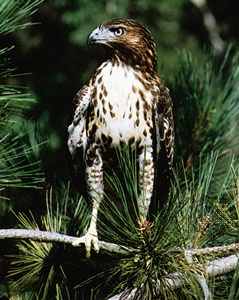hawk
bird
 any of various small to medium-sized falconiform birds, particularly those in the genus Accipiter, known as the true hawks, and including the goshawks and sparrowhawks. The term hawk is often applied to other birds in the family Accipitridae (such as the kites, buzzards, and harriers) and sometimes is extended to include certain members of the family Falconidae ( falcons and caracaras).
any of various small to medium-sized falconiform birds, particularly those in the genus Accipiter, known as the true hawks, and including the goshawks and sparrowhawks. The term hawk is often applied to other birds in the family Accipitridae (such as the kites, buzzards, and harriers) and sometimes is extended to include certain members of the family Falconidae ( falcons and caracaras).The great majority of hawks are more useful to humans than they are harmful, but there is still widespread prejudice against them. Occasionally they destroy poultry and smaller birds, but usually they eat small mammals, reptiles, and insects. Hawks have many foraging techniques, but the most typical in their pursuit of prey is raking, or swiftly following the animal's efforts to escape. Once the hawk has secured the prey with its powerful talons, the bird dismembers it with its sharply pointed, strong beak.
Hawks occur on the six major continents. Most species nest in trees, but some, such as the marsh hawk, nest on the ground in grassy places, and others nest on cliffs. They lay from three to six brown-spotted eggs.
 The so-called true hawks—members of the genus Accipiter (sometimes also called accipiters)—are exemplified by the sharp-shinned hawk (A. striatus), a bird with a 30-cm (12-inch) body length, gray above with fine rusty barring below, found through much of the New World, and by Cooper's hawk (A. cooperii), a North American species similar in appearance but larger—to 50 cm (20 inches) long. A long tail and short, rounded wings give these fast, low-flying birds great maneuverability. They feed on birds and small mammals; of all the New World raptors, Cooper's hawk is most suspect when poultry yards are raided. The goshawk and the sparrowhawk are also members of this group.
The so-called true hawks—members of the genus Accipiter (sometimes also called accipiters)—are exemplified by the sharp-shinned hawk (A. striatus), a bird with a 30-cm (12-inch) body length, gray above with fine rusty barring below, found through much of the New World, and by Cooper's hawk (A. cooperii), a North American species similar in appearance but larger—to 50 cm (20 inches) long. A long tail and short, rounded wings give these fast, low-flying birds great maneuverability. They feed on birds and small mammals; of all the New World raptors, Cooper's hawk is most suspect when poultry yards are raided. The goshawk and the sparrowhawk are also members of this group.The buteos (buteo), also called buzzard hawks, are broad-winged, wide-tailed, soaring raptors found in the New World, Eurasia, and Africa. The red-tailed hawk (Buteo jamaicensis), the most common North American species, is about 60 cm (24 inches) long, varying in colour but generally brownish above and somewhat lighter below with a rust-coloured tail. This beneficial hunter preys mainly on rodents, but it also catches other small mammals as well as various birds, reptiles (including rattlesnakes and copperheads), amphibians, and even insects. The red-shouldered hawk (B. lineatus), common in eastern and Pacific North America, is a reddish brown bird about 50 cm (20 inches) long, with closely barred underparts.
The black hawks are two species of short-tailed and exceptionally wide-winged black buteos. The great black hawk, or Brazilian eagle (Buteogallus urubitinga), about 60 cm (24 inches) long, ranges from Mexico to Argentina; the smaller common, or Mexican, black hawk (B. anthracinus) has some white markings and ranges from northern South America into the southwestern United States. Both species feed on frogs, fish, and other aquatic creatures.
Some other buteos are the following: Harris's, or the bay-winged, hawk (Parabuteo unicinctus), a large black bird with inconspicuous brown shoulders and flashing white rump, is found in South America and northward into the southwestern United States. The broad-winged hawk (B. platypterus), a crow-sized hawk, gray-brown with a black-and-white-banded tail, is found in eastern North America, where it migrates in large flocks. Swainson's hawk (B. swainsoni) is a bird of western North America that migrates to Argentina. Two notable rough-legged hawks are the ferruginous hawk (B. regalis)—the largest North American buzzard (up to 63 cm 【25 inches】 long)—and the rough-legged hawk (B. lagopus) of both the Old and New Worlds.
The African harrier hawk (Polyboroides typus) and the crane hawk (Geranospiza nigra) of tropical America are medium-sized gray birds resembling the harriers but having short, broad wings.
The relationship of the Accipitridae and the Falconidae creates some confusion regarding the classification and naming of species, and some names seem—to the layperson, at least—to be used interchangeably. For example, in the United States Circus cyaneus is known as the marsh hawk; the same bird is known in Britain as the hen harrier. Many falcons are known locally as hawks but have other, more widespread common names—e.g., the sparrowhawk, or kestrel; the duck hawk, or peregrine falcon; and the pigeon hawk, or merlin. Another related species, the fish hawk, is better known by the name osprey.
The unrelated birds called nighthawks (nighthawk) are not falconiforms but caprimulgiforms.
- Fredholm, Ivar
- Fred, Jr. Lazarus
- Fred Lazarus, Jr.
- Fred MacMurray
- Fred Merkle
- Fred M. Vinson
- Fredonia
- Fredric March
- Fredrika Bremer
- Fredrik Axel von Fersen
- Fredrik Bajer
- Fredriksson, Gert
- Fredrikstad
- Fredrik Størmer
- Fredro, Aleksander
- Fred Rogers
- Fred Stone
- Fred Thompson
- Fred W. Haise, Jr.
- Fred Zinnemann
- freeboard
- free church
- Free Church Federal Council
- Free Church of Scotland
- Freed, Arthur